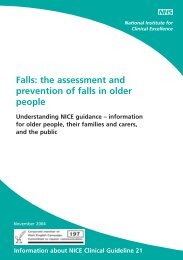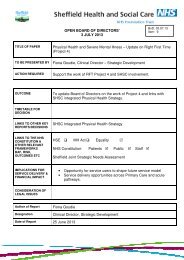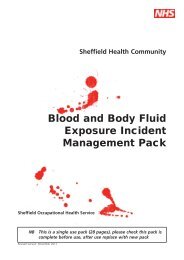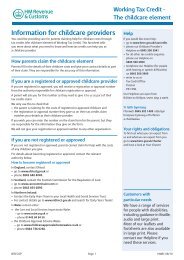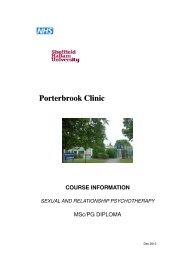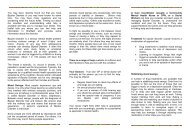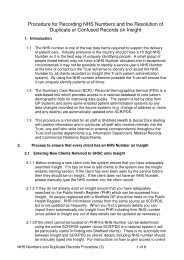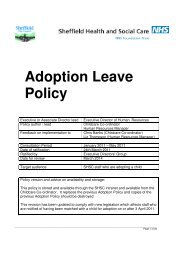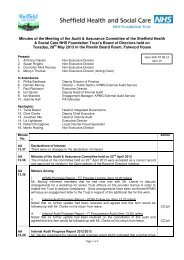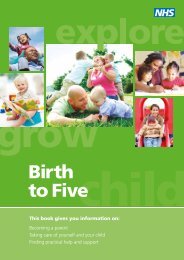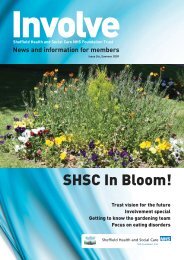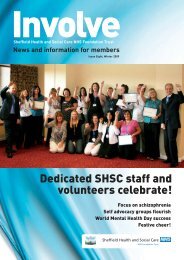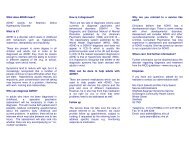Item 8 - Sheffield Health and Social Care
Item 8 - Sheffield Health and Social Care
Item 8 - Sheffield Health and Social Care
You also want an ePaper? Increase the reach of your titles
YUMPU automatically turns print PDFs into web optimized ePapers that Google loves.
Part 3: Review of ourquality performance3.1 SafetyOverall number of incidents reportedThe Trust traditionally reports a high numberof incidents compared to other organisations.This is viewed as a positive reflection of the safetyculture within the Trust. It helps us to be able to reallyunderst<strong>and</strong> what the experience of care is like, spottrends <strong>and</strong> make better decisions about what wewant to address <strong>and</strong> prioritise for improvement. TheNational Patient Safety Agency consistently assessesour performance, using the data supplied through theNational Reporting Learning System (NRLS) as in thehighest (best performing) 25% of Trust’s for activelyencouraging the reporting of incidents. For the 6month period April - September 2012, SHSC was the10th highest performer of 56 mental health trusts.Nationally, based on learning from incidents <strong>and</strong>errors across the NHS, the National patient SafetyAgency has identified a range of errors that shouldalways be prevented. These are often referred toas ‘never events’, because with the right systemsto support care <strong>and</strong> treatment in place they shouldnever need to happen again. None of the incidentsthat occurred within the Trust over the last yearwere of this category.Patient safety alertsThe NHS disseminates safety alerts through a CentralAlerting System. The Trust responded effectively toall alerts communicated through this system. During2012/13 the Trust received 70 non-emergency alertnotices, of which 100% were acknowledged within48 hours, 4 were applicable to the services provided bythe Trust <strong>and</strong> all were acted upon within the requiredtimescale. In addition a further 37 emergency alertswere received an acted upon straight away.Patient safety information on types of incidentsSelf-harm <strong>and</strong> suicide incidentsThe risk of self-harm or suicide is always a seriousconcern for mental health <strong>and</strong> substance misuseservices. The NPSA figures show 11.3% of allpatient safety incidents reported by the Trust wererelated to self harm, in comparison with 18.1% formental health trusts nationally. This is similar to theprevious year where the figures were 11.4% <strong>and</strong>18.7% respectively.During the last two years clinical risk trainingwas provided for SHSC staff <strong>and</strong> new clinical riskassessment <strong>and</strong> management tools have beenintroduced throughout the Trust. Last year 1,329staff from all professional groups received thetraining, which covers the principles <strong>and</strong> practice ofrisk assessment <strong>and</strong> management. We had plannedto train 2,000 members of staff. The main reasonleading to our under achievement of our target hasbeen capacity to support the release of staff fromfront line service delivery. We are reviewing ourapproaches to this for next year to ensure wecan deliver improvements.Violence, aggression <strong>and</strong> verbal abuseIn previous years the Trust has reported relativelylow incidents of disruptive <strong>and</strong> aggressive behaviourwithin our services compared to other mental healthorganisations. This has increased during 2012/13in line with the position reported in Section 2.20.6% of patient safety incidents reported by theTrust were for aggressive behaviour in comparisonwith a national average of 18.2%, based on NPSAbenchmarking data for first 6 months of the year.In the previous year, 2011/12 the figures were15.4% <strong>and</strong> 19% respectively.Medication errors <strong>and</strong> near missesStaff are encouraged to report near misses <strong>and</strong>errors that do not result in harm to make surethat they are able to learn to make the use <strong>and</strong>prescribing of medication as safe <strong>and</strong> effective aspossible. 6.1% of patient safety incidents reportedby the Trust related to medication, compared with8.4% in mental health trusts nationally. There hasbeen little change in the number of medicationincidents reported by the Trust over the last 3 years.Cleanliness <strong>and</strong> infection controlThe Trust is committed to providing clean safe carefor all our service users <strong>and</strong> ensuring that harm isprevented from irreducible infections.To achieve this an annual programme is producedby the Infection Prevention <strong>and</strong> Control Team thatdetails the methods <strong>and</strong> actions required to achievethese ends.The programme includes:• Processes to maintain <strong>and</strong> improve environments• The provision of extensive training <strong>and</strong> education• Systems for the surveillance of infections• Audit of both practice <strong>and</strong> environment <strong>and</strong>• The provision of expert guidance <strong>and</strong> informationto manage infection risks identified.The efficacy of this programme is monitored bothinternally <strong>and</strong> externally by the provision of quarterly<strong>and</strong> annual reports detailing the trusts progressagainst the programme. These reports are publiclyavailable via the internet.Single sex accommodationThe Trust is fully compliant with guidelines relatingto providing for appropriate facilities for men<strong>and</strong> women in residential <strong>and</strong> inpatient settings.During 2012/13 we have reported no breachesof these guidelines.SafeguardingThe Trust fully complies with its responsibilities<strong>and</strong> duties in respect of Safeguarding VulnerableAdults, <strong>and</strong> Safeguarding Children. We have aduty to safeguard those we come into contactwith through the delivery of our services. Wefulfil our obligations through ensuring we have:• Robust systems <strong>and</strong> policies in place thatare followed• The right training <strong>and</strong> supervision in placeto enable staff to recognise vulnerability<strong>and</strong> take action• Expert advice available to reduce the risksto vulnerable people.Reviews <strong>and</strong> investigationsWe aim to ensure that we review all our seriousincidents in a timely manner <strong>and</strong> share conclusions <strong>and</strong>learning with those effected, <strong>and</strong> our commissioners.We monitor our performance in respect ofcompleting investigations within 12 weeks <strong>and</strong>undertaking investigations that are assessed asbeing of an ‘excellent/ good’ st<strong>and</strong>ard. Historicallywe have experienced challenges in this area <strong>and</strong>we continue to prioritise our efforts to improveour review processes.Improvements <strong>and</strong> lessons learntAll incidents are reviewed to ensure we are able toidentify how we can make improvements <strong>and</strong> takecorrective action to maintain <strong>and</strong> improve safety.We formally review all serious incidents <strong>and</strong> theTrust’s Quality Assurance Committee <strong>and</strong> Board ofDirectors reviews the findings <strong>and</strong> lessons learnt fromthe incidents. We review <strong>and</strong> share all findings withour Commissioners <strong>and</strong> review our improvementplans with them.Examples of the types of improvement actions wehave been able to take following reviews of seriousincidents are• Involving service user families/carers in theircare/decision making• Comprehensive <strong>and</strong> timely record keeping,ensuring the rationale for decisions madeis recorded• Making sure that urgent referrals into theTrust are easily identified• Communication between NHS professionalsto be strengthened to ensure information isshared appropriately.Using incident data to prioritiseimprovement actionsFrom the incident data on the next page, <strong>and</strong> ourreview of the types of incidents that occur acrossour services, we prioritised falls <strong>and</strong> violent incidentsfor attention. Our plans, <strong>and</strong> progress against thoseplans is reported in detail in Quality Objectives 1 <strong>and</strong>2 in this report.Overview of incidents by typeThe table on the next page reports on the fullnumber of incidents reported within the Trust. It thenreports on the numbers of those incidents that werereported to result in harm for service users <strong>and</strong> staff.113114



